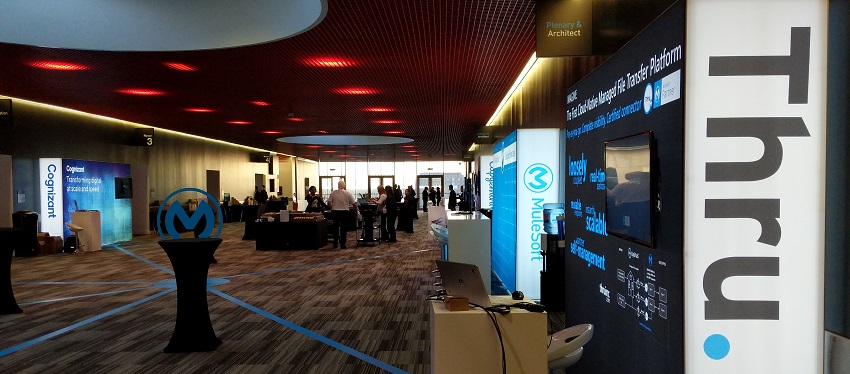
On November 13, 2018, two thousand plus IT leaders and developers gathered in London for the largest MuleSoft Summit to date. These one-day events are highly anticipated because they shine light on the latest in API-led technology and best practices that help companies better connect applications, data and devices. Thru’s team had a great time at the event discussing with developers and IT leaders how to integrate managed file transfer processes into their application networks via APIs.
The event’s opening keynote by Ross Mason, Founder of MuleSoft, powerfully set the tone for the day by stating “This is no longer about big companies eating the small, it’s the fast eating the slow” (via VanillaPlus).
The ability to quickly adapt to and serve consumer and partner expectations and make changes on the fly in a digitally dominated world is key (think of the new platform giants like Amazon, Salesforce, Netflix). It’s now about turning the company into a platform where it can quickly provide services to employees, customers and partners in an easily consumable way.
Decompose the “Ball of Mud” with Application Networks
Companies are stocking up on new applications like never before (e.g. artificial intelligence, IoT, CRMs, ERPs, email, file transfer systems). This has created a huge “big data ecosystem” that spans across on-premises and cloud locations. Each of these systems contain data and processes that need to be easily available across departments for various integration and automation use cases like digging into analytics for trend analysis, integrating a new trading partner system for B2B file exchange, etc.
Traditionally for departments to get access to data or connectivity with other systems they would submit a request to IT. Example of a project flow: An associate submits a request to IT for a new integration > IT builds an ad hoc (point-to-point) connection from scratch and the project could take weeks for development and testing.
This old method may have worked well for a time but now in the “big data world” it’s nearly impossible for IT to keep up with all of the new requests that are coming in like a flood.
Ross Mason described this mess of unstructured systems and integrations as a “ball of mud” that gets bigger and bigger as new applications and connections are added. Old point-to-point integration methods that are not reusable and tightly-coupled makes it difficult to connect new systems, manage all integrations and replace outdated applications.
Connecting with APIs
The best mechanism IT has to decompose this ball of mud, according to Mason, are APIs. But APIs alone cannot provide fluid integration across all endpoints. “We’re shifting from individual building blocks [APIs] to application networks. They’re needed because APIs don’t do much, they need this organizational structure,” said Mason.
According to MuleSoft, an application network is “a way to connect applications, data, and devices through APIs that exposes some or all of their assets and data on the network. That network allows other consumers from other parts of the business to come in and discover and use those assets.”
The first step in building an application network isn’t merely adopting a new technology but rather the company taking on a completely new perspective on how to use technology to solve problems. It requires an organization to step back and completely reorganize core systems to bring digital transformation to the whole business like its technology structure, business processes, change management and collaboration across the ecosystem.
MuleSoft aims to help companies easily design, build and manage application networks via APIs with its cloud-based Anypoint Platform and out-of-the-box connectors in the Anypoint Exchange. The platform provides IT departments with sophisticated tools for API design, security and application flow management.
“Having visibility into how things are connected will be massive and being able to effect change quickly is critical. Application networks will usher in a new IT operating model; increasing agility while securing your enterprise, creating a culture of self-service, and thriving in the face of change,” said Mason.
Thru Adds Reusable File Exchange Integration to the Application Network
Thru attended the MuleSoft Summit to discuss a requirement that will always remain within a company’s application ecosystem; the need to efficiently manage file exchange processes with trading partners (both cloud and on-premises) and be prepared for all short-term and long-term requirements.
Companies trying to connect outdated managed file transfer (MFT) systems to integration platforms like MuleSoft will find that integration is inflexible and time-consuming for developers to build and manage.
This daunting challenge involving disparate systems, multiple data formats and frequently changing data sources can be completed faster using Thru’s MFTaaS solution set and its MFT Connector for MuleSoft.
Thru is the first cloud-native MFT platform that enables companies to easily schedule, track and control file exchanges with partners in the digital business ecosystem. When coupled with Thru MFT Connector for MuleSoft, companies using Thru’s cloud-based MFT platform can instantly connect B2B file exchange workflows to business processes running in their MuleSoft application network. Partners can self-subscribe to file exchange processes in Thru so MuleSoft developers do not need to write any code and do not need any partner endpoint details to add into Mule flows.
Read the white paper, Managed File Transfer for the Extended Enterprise, and learn how Thru simplifies file exchange and workflow implementation with any number of external partners and internal lines of business.
Read about the latest 5 Takeaways from Mulesoft Connect 2019 in San Francisco >>
